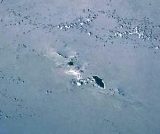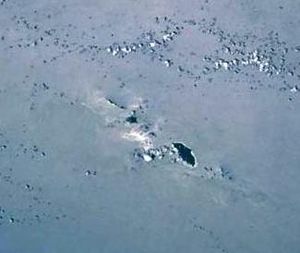
Duff Islands
Encyclopedia
The Duff Islands are a small island group lying to the northeast of the Santa Cruz Islands
in the Solomon Islands
province of Temotu
. They are also sometimes known as the Wilson Islands.
 The islands are located at 9°51'48" S. lat.
The islands are located at 9°51'48" S. lat.
, 167°4'48" E. long.
The Duff Islands consist of:
Frequently, Hallie Jackson Reef is mentioned in the context of the Duff islands, although it is located 45 km west of the 32 km long island chain, and although it is no island, but at most a submarine reef
. In the Sailing Directions
of 1969 Hallie Jackson Reef is described as a reef 24 feet deep, at 9°44'S, 166°07'E.. The corresponding current (2010) publication has no mention of the reef anymore..
The inhabitants of the Duff Islands are Polynesians
, and their language, Pileni
, is a member of the Samoic
branch of Polynesian languages
.
On the islands of Duff live about 500 people.
The way of life is traditional by subsistence farming and fishing. Taumako has no roads, airport, telephones, or electricity. Contact with outsiders comes by battery-powered marine radio and the occasional cargo ship.
The Duff Islands were named after missionary ship Duff, captained by James Wilson
, which reached them in 1797.
and Marianne (Mimi) George uncovered that full traditional Polynesian navigational technique is still preserved in these islands (Finney and Lowe, 2006, p163).
Santa Cruz Islands
The Santa Cruz Islands are a group of islands in the Pacific Ocean, part of Temotu Province of the Solomon Islands. They lie approximately 250 miles to the southeast of the Solomon Islands Chain...
in the Solomon Islands
Solomon Islands
Solomon Islands is a sovereign state in Oceania, east of Papua New Guinea, consisting of nearly one thousand islands. It covers a land mass of . The capital, Honiara, is located on the island of Guadalcanal...
province of Temotu
Temotu
Temotu can refer to:* Temotu Province, a province of the Solomon Islands* Temotu, Tuvalu, an island in Vaitupu, Tuvalu* Temotu, Kiribati, a village on Marakei, Kiribati...
. They are also sometimes known as the Wilson Islands.

Latitude
In geography, the latitude of a location on the Earth is the angular distance of that location south or north of the Equator. The latitude is an angle, and is usually measured in degrees . The equator has a latitude of 0°, the North pole has a latitude of 90° north , and the South pole has a...
, 167°4'48" E. long.
Longitude
Longitude is a geographic coordinate that specifies the east-west position of a point on the Earth's surface. It is an angular measurement, usually expressed in degrees, minutes and seconds, and denoted by the Greek letter lambda ....
The Duff Islands consist of:
- TaumakoTaumakoTaumako is the largest of the Duff Islands. This 5.7 km long island has steep sides and rises to a height of 400 m above sea level. It is composed of basaltic lavas and pyroclastics like the other islands in the Duffs ....
, the main island, with nearby Tahua and Tohua - The Bass Islands: Lua, Kaa and Loreva
- Treasurer's Islands: Tuleki (Anula), Elingi (Obelisk Island), Te Aku (Te Ako), Lakao and Ulaka
Frequently, Hallie Jackson Reef is mentioned in the context of the Duff islands, although it is located 45 km west of the 32 km long island chain, and although it is no island, but at most a submarine reef
Reef
In nautical terminology, a reef is a rock, sandbar, or other feature lying beneath the surface of the water ....
. In the Sailing Directions
Sailing Directions
Sailing Directions is a 42-volume American navigation publication published by the National Geospatial-Intelligence Agency . Sailing Directions consists of 37 Enroute volumes, 4 Planning Guide volumes, and 1 volume combining both types...
of 1969 Hallie Jackson Reef is described as a reef 24 feet deep, at 9°44'S, 166°07'E.. The corresponding current (2010) publication has no mention of the reef anymore..
The inhabitants of the Duff Islands are Polynesians
Polynesians
The Polynesian peoples is a grouping of various ethnic groups that speak Polynesian languages, a branch of the Oceanic languages within the Austronesian languages, and inhabit Polynesia. They number approximately 1,500,000 people...
, and their language, Pileni
Pileni language
Vaeakau-Taumako is a Polynesian language spoken in some of the Reef Islands as well as in the Taumako Islands in the Temotu province of the Solomon Islands....
, is a member of the Samoic
Samoic languages
The Samoic–Outlier languages, also known as Samoic languages, are a purported group of Polynesian languages, encompassing the Polynesian languages of Samoa, Tuvalu, American Samoa, Tokelau, Wallis and Futuna, and Polynesian outlier languages in New Caledonia, the Solomon Islands, Vanuatu, Papua New...
branch of Polynesian languages
Polynesian languages
The Polynesian languages are a language family spoken in the region known as Polynesia. They are classified as part of the Austronesian family, belonging to the Oceanic branch of that family. They fall into two branches: Tongic and Nuclear Polynesian. Polynesians share many cultural traits...
.
On the islands of Duff live about 500 people.
The way of life is traditional by subsistence farming and fishing. Taumako has no roads, airport, telephones, or electricity. Contact with outsiders comes by battery-powered marine radio and the occasional cargo ship.
The Duff Islands were named after missionary ship Duff, captained by James Wilson
James Wilson (Captain)
Captain James Wilson , brought the first British missionaries to Tahiti on ship Duff in 1797.Wilson was a deeply religious man. The missionaries he brought were from the London Missionary Society...
, which reached them in 1797.
Traditional Navigation
Studies of David LewisDavid Henry Lewis
David Henry Lewis, DCNZM was a sailor, adventurer, doctor, and Polynesian scholar. He is best known for his studies on the traditional systems of navigation used by the Pacific Islanders...
and Marianne (Mimi) George uncovered that full traditional Polynesian navigational technique is still preserved in these islands (Finney and Lowe, 2006, p163).
See also
- MelanesiaMelanesiaMelanesia is a subregion of Oceania extending from the western end of the Pacific Ocean to the Arafura Sea, and eastward to Fiji. The region comprises most of the islands immediately north and northeast of Australia...
- OceaniaOceaniaOceania is a region centered on the islands of the tropical Pacific Ocean. Conceptions of what constitutes Oceania range from the coral atolls and volcanic islands of the South Pacific to the entire insular region between Asia and the Americas, including Australasia and the Malay Archipelago...
- Pacific IslandsPacific IslandsThe Pacific Islands comprise 20,000 to 30,000 islands in the Pacific Ocean. The islands are also sometimes collectively called Oceania, although Oceania is sometimes defined as also including Australasia and the Malay Archipelago....
- Pacific OceanPacific OceanThe Pacific Ocean is the largest of the Earth's oceanic divisions. It extends from the Arctic in the north to the Southern Ocean in the south, bounded by Asia and Australia in the west, and the Americas in the east.At 165.2 million square kilometres in area, this largest division of the World...
- Polynesian outlierPolynesian outlierPolynesian outliers are a number of culturally Polynesian islands which lie in geographic or political Melanesia and Micronesia. Based on archaeological and linguistic analysis, these islands are believed to have been colonized by seafaring Polynesians, mostly from the area of Tonga, Samoa and...

